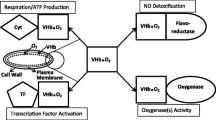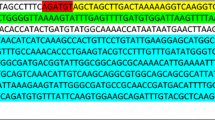Abstract
The gene (vgb) encoding Vitreoscilla (bacterial) hemoglobin (VHb) was electroporated into Gordonia amarae, where it was stably maintained, and expressed at about 4 nmol VHb g−1 of cells. The maximum cell mass (OD600) of vgb-bearing G. amarae was greater than that of untransformed G. amarae for a variety of media and aeration conditions (2.8-fold under normal aeration and 3.4-fold under limited aeration in rich medium, and 3.5-fold under normal aeration and 3.2-fold under limited aeration in mineral salts medium). The maximum level of trehalose lipid from cultures grown in rich medium plus hexadecane was also increased for the recombinant strain, by 4.0-fold in broth and 1.8-fold in cells under normal aeration and 2.1-fold in broth and 1.4-fold in cells under limited aeration. Maximum overall biosurfactant production was also increased in the engineered strain, by 1.4-fold and 2.4-fold for limited and normal aeration, respectively. The engineered strain may be an improved source for producing purified biosurfactant or an aid to microorganisms bioremediating sparingly soluble contaminants in situ.



Similar content being viewed by others

References
Arenskotter M, Broker D, Steinbuchel A (2004) Biology of the metabolically diverse genus Gordonia. Appl Environ Microbiol 70:3195–3204
Banat IM, Makkar RS, Cameotra SS (2000) Potential commercial applications of microbial surfactants. Appl Microbiol Biotechnol 53:495–508
Beveridge TJ (1990) Mechanism of gram variability in select bacteria. J Bacteriol 172:1609–1620
Buddenhagen RE, Webster DA, Stark BC (1996) Enhancement by bacterial hemoglobin of amylase production in recombinant E. coli occurs under conditions of low O2. Biotechnol Lett 18:695–700
Cha DK (1990) Process control factors influencing Nocardia populations in activated sludge. PhD Dissertation, University of California, Berkley
Chung JW, Webster DA, Pagilla KR, Stark BC (2001) Chromosomal integration of the Vitreoscilla hemoglobin gene in Burkholderia and Pseudomonas for the purpose of producing stable engineered strains with enhanced bioremediating ability. J Ind Microbiol Biotechnol 27:27–33
Cooper DG, Zajic JE (1980) Surface active compounds from microorganisms. Adv Appl Microbiol 26:229–253
Davis JB (1964) Cellular lipids of a Nocardia grown on propane and n-butane. Appl Microbiol 12:301–304
De Modena JA, Gutierrez S, Velasco J, Fernandez FJ, Fachini RA, Galazzo JL, Hughes DE, Martin JF (1993) The production of cephalosporin C by Acremonium chrysogenum is improved by the intracellular expression of a bacterial hemoglobin. Biotechnology 11:926–929
Dikshit KL, Webster DA (1988) Cloning, characterization and expression of the bacterial globin gene from Vitreoscilla in E. coli. Gene 70:377–386
Farres J, Kallio PT (2002) Improved cell growth in tobacco suspension cultures expressing Vitreoscilla hemoglobin. Biotechnol Prog 18:229–233
Georgiou G, Lin S-C, Sharma MM (1992) Review of surface-active compounds from microorganisms. Biotechnology 10:60–65
Hodge JE, Hofreiter BT (1962) Determination of reducing sugars and carbohydrates. Methods Carbohydr Chem 1:389–390
Holmberg N, Lilius G, Bailey JE, Bulow L (1997) Transgenic tobacco expressing Vitreoscilla hemoglobin exhibits enhanced growth and altered metabolite production. Nat Biotechnol 15:244–247
Holmes DS, Quigley M (1981) A rapid boiling method for the preparation of bacterial plasmids. Anal Biochem 114:193–197
Kallio PT, Kim DJ, Tsai PS, Bailey JE (1994) Intracellular expression of Vitreoscilla hemoglobin alters Escherichia coli energy metabolism under oxygen-limited conditions. Eur J Biochem 219:201–208
Kang DG, Kim JYH, Cha HJ (2002) Enhanced detoxification of organophosphates using recombinant Escherichia coli with coexpression of organophosphorus hydrolase and bacterial hemoglobin. Biotechnol Lett 24:879–883
Kayser KJ, Kilbane JJ (2001) New host-vector system for Thermus spp. based on the malate dehydrogenase gene. J Bacteriol 183:1792–1795
Lang S, Wagner F (1987) Structure and properties of biosurfactants. In: Kosaric N, Cairns WL (eds) Biosurfactants and biotechnology. Marcel Dekker, New York, pp 21–46
Lee SY, Stark BC, Webster DA (2004) Structure-function studies of the Vitreoscilla hemoglobin D-region. Biochem Biophys Res Commun 316:1101–1106
Lin JM, Stark BC, Webster DA (2003) Effects of Vitreoscilla hemoglobin on the 2,4-dinitrotoluene (DNT) dioxygenase activity of Burkholderia and on DNT degradation in two-phase bioreactors. J Ind Microbiol Biotechnol 30:362–368
Liu SC, Webster DA, Stark BC (1995) Cloning and expression of the Vitreoscilla hemoglobin gene in Pseudomonads: effects on cell growth. Appl Microbiol Biotechnol 44:419–424
MacDonald CR, Cooper DG, Zajic JE (1981) Surface-active lipids from Nocardia erythropolis grown on hydrocarbons. Appl Environ Microbiol 41:117–123
Magnolo SK, Leenutaphong DL, De Modena JA, Curtis JE, Bailey JE, Galazzo JL, Hughes DE (1991) Actinorhodin production by Streptomyces coelicolor and growth of Streptomyces lividans are improved by the expression of a bacterial hemoglobin. Biotechnology 9:473–476
Margaritis A, Kennedy K, Zajic JE, Gerson DF (1979) Biosurfactant production by Nocardia erythropolis. Dev Ind Microbiol 20:623–630
Mazodier P, Petter R, Thompson C (1989) Intergeneric conjugation between E. coli and Streptomyces species. J Bacteriol 171:3583–3585
Miller JH (1972) Experiments in molecular genetics. Cold Spring Harbor Laboratory, Cold Spring Harbor
Pagilla KR, Kim H, Sood A (2002) Gordonia amarae foaming due to biosurfactant production. Water Sci Technol 46:519–524
Parales RE, Bruce NC, Schmid A, Wackett LP (2002) Biodegradation, biotransformation, and biocatalysis (B3). Appl Environ Microbiol 68:4699–4709
Park KW, Kim KJ, Howard AJ, Stark BC, Webster DA (2002) Vitreoscilla hemoglobin binds to subunit I of cytochrome bo ubiquinol oxidases. J Biol Chem 277:33334–33337
Pendse GJ, Bailey JE (1994) Effect of Vitreoscilla hemoglobin expression on growth and specific tissue plasminogen activator productivity in recombinant Chinese hamster ovary cells. Biotechnol Bioeng 44:1367–1370
Ramendeep, Hwang KW, Raje M, Kim KJ, Stark BC, Dikshit KL, Webster DA (2001) Vitreoscilla hemoglobin: intracellular localization and binding to membranes. J Biol Chem 276:24781–24789
Roos V, Andersson CIJ, Bulow L (2004) Gene expression profiling of Escherichia coli expressing double Vitreoscilla haemoglobin. J Biotechnol 114:107–120
Schafer A, Kalinowski J, Simon R, Seep-Feldhaus A-H, Puhler A (1990) High-frequency conjugal plasmid transfer from Gram-negative E. coli to various Gram-positive coryneform bacteria. J Bacteriol 172:1663–1666
Stark BC, Webster DA, Dikshit KL (1999) Vitreoscilla hemoglobin: molecular biology, biochemistry, and practical applications. Recent Res Dev Biotech Bioeng 2:155–174
Sutton R (1992) Removal of sparingly soluble organic chemicals from aqueous solutions by biosurfactants produced by Nocardia amarae. MS Thesis, Illinois Institute of Technology, Chicago
Trieu-Cuot P, Carlier C, Martin P, Courvalin P (1987) Plasmid transfer by conjugation from E. coli to Gram-positive bacteria. FEMS Microbiol Lett 48:289–294
Tsai PS, Hatzimanikatis V, Bailey JE (1996) Effect of Vitreoscilla hemoglobin dosage on microaerobic Escherichia coli carbon and energy metabolism. Biotechnol Bioeng 49:139–150
Urgun-Demirtas M, Pagilla KR, Stark BC, Webster DA (2003) Biodegradation of 2-chlorobenzoate by recombinant Burkholderia cepacia expressing Vitreoscilla hemoglobin under variable levels of oxygen availability. Biodegradation 14:357–365
Urgun-Demirtas M, Pagilla KR, Stark BC (2004) Enhanced kinetics of genetically engineered Burkholderia cepacia: role of vgb in the hypoxic metabolism of 2-CBA. Biotechnol Bioeng 87:110–118
Acknowledgements
This work was supported by NSF grant number MCB-9910356. We thank Dr. John Kilbane for helpful discussions, Dr. Kevin Kayser for help with electroporation, and Dr. Sangeeta Patel for help with the Gram staining.
Author information
Authors and Affiliations
Corresponding author
Rights and permissions
About this article
Cite this article
Dogan, I., Pagilla, K.R., Webster, D.A. et al. Expression of Vitreoscilla hemoglobin in Gordonia amarae enhances biosurfactant production. J IND MICROBIOL BIOTECHNOL 33, 693–700 (2006). https://doi.org/10.1007/s10295-006-0097-0
Received:
Accepted:
Published:
Issue Date:
DOI: https://doi.org/10.1007/s10295-006-0097-0



